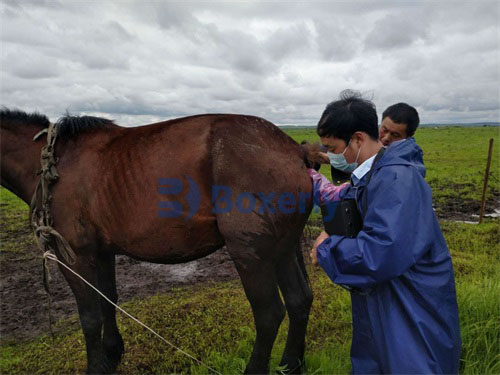For many horse breeders and equine veterinarians, transporting pregnant mares is often an unavoidable part of managing breeding operations, sales, or competition schedules. Yet transport stress poses a significant risk to both maternal well-being and fetal development. From elevated cortisol levels and disrupted heart rhythms to spontaneous abortions and behavioral changes, the stress response in pregnant horses exposed to transport conditions is a serious issue—and one that demands both scientific understanding and practical management strategies.

Trong bài viết này, we explore the stress response patterns in pregnant mares during transportation. Drawing on international studies and field practices, we examine the physiological, hormonal, and behavioral signs of transport-induced stress, factors that exacerbate risk, and best practices to reduce harm. Whether you’re a breeder, vet, or horse transporter, understanding these mechanisms is vital to improving welfare and ensuring safe pregnancies.
Understanding Equine Stress Physiology
In horses, stress activates both the hypothalamic-pituitary-adrenal (HPA) axis and the sympathetic nervous system. This leads to the release of glucocorticoids—mainly cortisol—as well as catecholamines like adrenaline and noradrenaline. While this response is adaptive in short bursts, chronic or repeated activation—such as during prolonged transport—can have harmful effects on the mare and fetus.
Pregnant mares are particularly vulnerable. During gestation, the endocrine system is finely balanced to support fetal development. Even minor hormonal imbalances can have outsized effects, especially during early gestation and the final trimester.
In a study by Padalino et al. (2017), cortisol concentrations were significantly higher in pregnant mares subjected to a 12-hour transport versus those kept in stable conditions. Elevated cortisol can interfere with progesterone secretion, potentially threatening the maintenance of pregnancy. Additionally, increased uterine contractility, another stress-induced response, may precipitate premature labor or fetal loss.
Behavioral and Physiological Stress Markers During Transport
Stress in pregnant horses manifests across several dimensions:
1. Hormonal Changes:
Elevated plasma cortisol is the most studied marker. Cortisol spikes typically occur within the first hour of transport and remain high for several hours afterward. Horses with prior negative transport experiences show more significant cortisol surges.
2. Heart Rate and Variability:
Heart rate monitors have shown increased beats per minute and decreased heart rate variability (HRV) in transported mares, indicating elevated sympathetic activity and reduced parasympathetic tone—both markers of acute stress.
3. Gastrointestinal Disruption:
Stress reduces gastrointestinal motility, increasing the risk of colic. Mares exposed to transport often show changes in gut sounds and fecal output, reflecting physiological distress.
4. Behavioral Signs:
Transported mares often exhibit pawing, vocalization, weaving, and increased defecation frequency. These behavioral signs, especially when prolonged, correlate strongly with physiological stress.
Timing of Gestation and Stress Sensitivity
Not all gestational stages respond equally to stress. International veterinary guidelines and research suggest:
-
First Trimester (0–3 months): This is the period of highest sensitivity. Embryonic attachment and early placental formation are vulnerable to endocrine disruption. Transport during this phase is associated with increased risk of early embryonic loss.
-
Second Trimester (4–8 months): Mares generally tolerate stress better during this period. The placenta is well-established, and fetal development is robust. However, long-haul transport still presents risks, especially in hot or cold weather.
-
Third Trimester (9–11 months): Close to foaling, uterine contractions triggered by stress can lead to premature labor. Monitoring is critical if mares must be moved at this stage.
Environmental and Managerial Stress Factors
Transport stress is multifactorial. Among the key environmental and management-related contributors are:
1. Duration and Distance:
Longer transport times correlate with higher cortisol levels and more pronounced behavioral distress. Research from the University of Queensland found that mares transported over 800 km had threefold cortisol increases compared to short-haul (under 200 km) counterparts.
2. Trailer Design and Ventilation:
Poor air quality, excessive vibration, and inadequate space amplify stress. Horses in slant-load trailers typically exhibit less stress than those in straight-load configurations.
3. Social Isolation:
Mares transported alone tend to exhibit higher heart rates and behavioral anxiety. Group transport (with visual or tactile contact) reduces perceived threat and physiological stress.
4. Feeding and Hydration:
Dehydration and fasting before or during transport heighten stress responses. Access to hay and water during transport can mitigate this.

Practical Recommendations to Minimize Stress
Based on insights from European and American equine transport guidelines, the following measures are effective in reducing stress during transport:
-
Schedule Transport During the Second Trimester: When possible, avoid transporting mares during the first 45 days of pregnancy or within one month of expected foaling.
-
Preconditioning to Trailers: Allowing mares to gradually acclimate to loading and transport conditions reduces fear-based responses during actual travel.
-
Use of Sedatives or Tranquilizers: In certain high-risk mares, veterinarians may prescribe mild sedatives to reduce stress. However, these should be used with caution and under close supervision.
-
Monitoring Tools: Portable devices like heart rate monitors, and non-invasive saliva cortisol kits, allow for real-time assessment of stress. Future innovations may include wearable biosensors for continuous monitoring.
-
Environmental Enrichment: Transport trailers fitted with rubber flooring, padded partitions, and proper ventilation create a safer and more comfortable experience for pregnant mares.
International Perspectives and Welfare Regulations
Countries like Germany, the UK, Úc, and the U.S. have established codes of practice for equine transport. Most recommend:
-
Rest stops every 4–8 hours
-
Limiting total travel time for pregnant mares to under 12 hours
-
Post-transport recovery of 1–2 days with full veterinary observation
Transport stress is increasingly recognized in animal welfare laws. The World Organisation for Animal Health (WOAH) includes recommendations for pregnant animal transport in its Terrestrial Animal Health Code, with emphasis on minimizing stress and ensuring veterinary oversight.
Future Directions in Monitoring Stress
Veterinary ultrasonography, though traditionally used for pregnancy diagnosis, is now being investigated as a non-invasive tool to monitor uterine contractility and fetal stress in transported mares. B-mode ultrasound can assess fetal heart rate and amniotic fluid volume post-transport, which may offer clues about in utero stress.
In one Australian trial, researchers scanned 30 pregnant mares before and after an 8-hour transport. Mild changes in fetal position and fluid dynamics were noted in 20% of cases—although none resulted in loss, it highlighted the importance of post-transport checks.

Kết thúc
Transporting pregnant horses is a necessary but high-stakes task. The stress response in pregnant mares is a complex interplay of hormonal, physiological, and behavioral changes that can affect not only the dam’s health but also the viability of the pregnancy. Understanding the timing of gestation, the influence of environmental factors, and the mechanisms of stress is critical to planning safe and humane transport.
For breeders, veterinarians, and transport professionals, investing in stress-reducing strategies is more than a welfare decision—it’s a commitment to reproductive success and long-term herd health. With proper planning, monitoring, and care, the risks can be greatly minimized.
References
Padalino, B., Raidal, S. L., Hall, E., Knight, P., Celi, P., & Jeffcott, L. (2017). “Effects of transport conditions on behavioral and physiological responses of horses.” Journal of Veterinary Behavior, 19, 128-135. https://doi.org/10.1016/j.jveb.2017.03.001
McGreevy, P. D., & McLean, A. N. (2010). Equitation Science. Wiley-Blackwell.
World Organisation for Animal Health (WOAH). Terrestrial Animal Health Code – Chapter 7.3. https://www.woah.org/en/what-we-do/standards/codes-and-manuals/terrestrial-code-online-access/
University of Queensland Equine Research Unit. (2022). “Transport and stress management in pregnant mares.” https://agriculture.uq.edu.au/research/equine-transport-stress